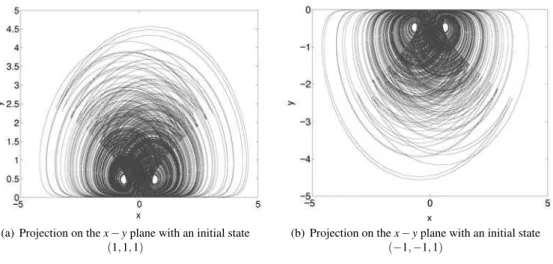A 3-D four-wing attractor and its analysis
Zenghui Wang∗
F’SATIE, Department of Electrical Engineering, Tshwane University of Technology, Pretoria 0001, South Africa and Department of Automation, Shandong University of Science & Technology, Qingdao 266510, China
Yanxia Sun,† Barend Jacobus van Wyk, and Guoyuan Qi
F’SATIE, Department of Electrical Engineering, Tshwane University of Technology, Pretoria 0001, South Africa
Michael Antonie van Wyk
School of Electrical and Information Engineering, University of the Witwatersrand, Johannesburg 2000, South Africa (Received on 14 April, 2009)
In this paper, several three dimensional (3-D) four-wing smooth quadratic autonomous chaotic systems are analyzed. It is shown that these systems have a number of similar features. A new 3-D continuous autonomous system is proposed based on these features. The new system can generate a four-wing chaotic attractor with less terms in the system equations. Several basic properties of the new system is analyzed by means of Lyapunov exponents, bifurcation diagrams and Poincare maps. Phase diagrams show that the equilibria are related to the existence of multiple wings.
Keywords: Chaos; four-wing attractor; Lyapunov exponents; bifurcation.
1. INTRODUCTION
Since Lorenz discovered a simple three-dimensional smooth autonomous chaotic system in 1963 [1], it was found that chaos is very useful in many application fields such as engineering, medicine, secure communications, and so on. Much research was done in this field [2, 3]. Creating a chaotic system with a more complicated topological structure such as a multi-scroll or multi-wing attractor, therefore, becomes a desirable task and sometimes a key issue for many engineering applications. In this endeavor, there are two major thrusts: generalizing Chua’s circuits with multi-scroll attractors and generalizing the Lorenz system with multi-wing attractors. In efforts to generalize Chua’s circuit [4] to produce multi-scroll attractors, several effective techniques have been developed, including gener-alized Chua’s circuits and cellular neural networks [5, 6]. In [4, 5, 7], the piecewise-linear (PWL) function method was utilized, which can increase the number of equilibria by adding breakpoints. A sine-function approach was then proposed for creating multi-scroll chaotic attractors [8]. Later, a stair function was used for generating 3D-grid-scroll attractors [9, 10]. More recently, several different nonlinear functions including switching, hysteresis and saturated functions were utilized for creating chaotic attractors with multi-merged basins of attraction, or with multi-scroll attractors [11–14]. Note that the aforementioned methods for generating multi-scroll attractors have some common characteristics [15, 16]:
(i) The nonlinearities of these systems are usually not smooth functions; they are either piecewise-linear contin-uous functions or discontincontin-uous ones such as the staircase function, switching function, and hysteresis-series function. (ii) The basic techniques either increase the number of equilibria via PWL functions with more breakpoints, or use
∗Electronic address:wangzengh@gmail.com †Electronic address:sunyanxia@gmail.com
stair or hysterisis functions to realize equilibrium jumping. (iii) The number of scrolls equals the number of equilibria. (iv) The basic shape of the attractors is cyclic, called a scroll.
Another major thrust has been the generalization of the Lorenz system [17]. Recently some new chaotic systems were proposed, including the Chen system, the generalized Lorenz system family, and the hyperbolic-type of general-ized Lorenz canonical form [18–20]. Some four-dimensional chaotic systems were also presented, which have more com-plicated dynamic properties than three-dimensional chaotic systems, such as the system proposed in [21]. It can be seen that the characteristics of generalized Chua’s circuits are dif-ferent from the generalized Lorenz systems. For example, the nonlinearities of these systems are usually smooth func-tions, the number of wings is not equal to the number of equilibria and the basic shape of the attractors is a butterfly, called a wing [15, 22]. Qi proposed two four-wing chaotic attractors produced by 4-D systems with complicated struc-ture [16, 22].
In fact, most of the multi-scroll attractors were generated by increasing the breakpoints in the non-linearity. Recently, a four-wing or three-wing butterfly attractor was generated from a three-dimensional system [23] by relying on two em-bedded state-controlled binary switches. However, these sys-tems are usually not smooth syssys-tems.
(a) Projection on thex−yplane (b) Projection on thex−zplane
(c) Projection on they−zplane (d) 3-D view by ’.’ in thex−y−zspace FIG. 1: Four-wing chaotic attractor, witha=0.2,b=−0.01,c=1,d=−0.4,e=−1.0 andf=−1.
2. 3-D FOUR-WING SMOOTH AUTONOMOUS CHAOTIC SYSTEMS
FIG. 2: The bifurcation diagram of the system (6) with respect tob, and witha=0.2,c=1,d=−0.4,e=−1.0 andf=−1.
In [24, 25], a three-dimensional smooth quadratic au-tonomous system which seemingly can produce a four-wing attractor was proposed. At first, it was believed that this system could produce a four-wing chaotic attractor, termed a four-scroll attractor but this was then later shown by the same authors to be a numerical artifact. It was not a real four-wing chaotic attractor but consisted of two coexisting
and closely located double-wing attractors [26]. In [27], a 3-D autonomous quadratic system was reported, which can generate a single four-scroll attractor. For the simplicity of comparison, the system is parameterized as
˙
x1 = a1x1−y1z1+a2, ˙
y1 = b1y1+x1z1, (1) ˙
z1 = c1z1+x1y1, wherea1,a2,b1,c1are real constants. If
⎧ ⎪ ⎪ ⎨
⎪ ⎪ ⎩
b1c1>0, a1=0,
a1√b1c1<min(−a2,a2) ifb1>0, a1√b1c1>max(−a2,a2) ifb1<0, there are five equilibria in this system, given by
S0 = (− a2 a1
,0,0),
S1,2 = (p,±
(−a2−a1p)b1
p p,±
(−a2−a1p)b1
p ),
S3,4 = (−p,∓
(a2−a1p)b1
p p,±
(a2−a1p)b1
p ),
equation in (1). Consider the following transformation of variables:
x1=x2− a2 a1 .
The system (1) can be reformulated as
˙
x2 = a1x2−y1z1, ˙
y1 = b1y1− a2 a1
z1+x2z1, (2) ˙
z1 = cz1− a2 a1
y1+x2y1,
which has a trivial equilibrium and is equivalent to system (1). Another example is given by
FIG. 3: The maximum Lyapunov exponent spectrum of the system (6) with respect tob, and witha=0.2,c=1,d=−0.4,e=−1.0 andf=−1.
˙
x1 = a1x1+a2y1+y1z1, ˙
y1 = b2y1−x1z1+b23y1z1, (3) ˙
z1 = c3z1−x1y1.
When a1 = 0.5,a2 = 0.15;b2 = −12.2,b23 = 1.0,c3 = −8.79, the system has a real four-scroll attractor with eight cross product terms on the right [28].
Qi [15] introduced a 3-D quadratic autonomous system
˙
x1 = a1(y1−x1) +e1y1z1, ˙
y1 = c1x1+d1y1−x1z1, (4) ˙
z1 = −b1z1+x1y1,
called the Qi 3-D four-wing system, which can generate two coexisting single-wing chaotic attractors and a pair of diag-onal double-wing chaotic attractors. The system can also generate a four-wing chaotic attractor with very complicated topological structures over a large range of parameters.
Recently, Chen [29] presented a new three-dimensional smooth quadratic autonomous chaotic system,
˙
x1 = a1x1+ky1−y1z1, ˙
y1 = −b1y1−z1+x1z1, (5) ˙
z1 = −x1−c1z1+x1y1.
which can evolve into periodic and chaotic orbits in case of different parameters. When proper parameters are chosen, a single four-wing attractor and a single three-wing attractor appears.
As can be seen from systems (2), (3), (4) and (5), there are a number of similar features common to these chaotic sys-tems:
(1)There is at least one quadratic term in every equation, which means there is at least three quadratic terms in one system.
(2)There are five equilibria when these chaotic systems dis-play four wings.
(3)There are at least four linear terms, and there is at least one linear term in every equation of these systems.
The logical question is whether there is any system ex-hibiting similar behavior, but with less linear and quadratic terms than these systems.
3. A NEW 3-D FOUR-WING SMOOTH AUTONOMOUS CHAOTIC SYSTEMS
Based on the above features, a new simpler chaotic system
˙
x = ax+cyz, ˙
y = bx+dy−xz, (6)
˙
z = ez+f xy,
is proposed. Herea,b,d,e∈R,c>0 and f <0 are all con-stants,c f=0, andx,y,zare the state variables. If the system is dissipative,∇V=∂x˙
x +
∂y˙
y +
∂z˙
z =a+d+eshould be less
than zero, that is,a+d+e<0. This implies that a volume elementV0is contracted by the flow into a volume element V0e(a+d+e)tin timet.
Theorem 1 If b=0, the system (6) can not generate a four-wing chaotic attractor.
Proof: This theorem can be proved according to different cases in parameter space.
Case 1:c<0
Ifb=0, consider the first and the second equations of (6), i.e.
˙
x = ax+cyz, (7)
˙
y = dy−xy. (8)
By multiplying both sides of (7) byxand of (8) bycy, re-spectively, the two equations become
˙
xx = ax2+cxyz, (9)
cyy˙ = cdy2−cxyz. (10) By adding both sides of (9) and (10), one obtains
˙
xx+cyy˙ =ax2+cdy2. (11) Equation (11) is equivalent to
d(x2+cy2) dt =2d(x
2+cy2) + (2a−2d)x2
Solving the above equation yields
x2+cy2=e2dt
Z t
0
e−2dt(2a−2d)x2dτ+ (x2 0+cy20)
, (13) wherex0andy0are the initial state of system (6).
Ifa>dand|x0|>√−c|y0|, according to (13), one obtains x2+cy2>0⇒ |x|>√−c|y|. (14) If |x0|>√−c|y0| andz0=0, then for any timet>0, the system trajectory in the x−yplane will never travel from one domainx>0 to another,x<0, or vice versa. That is, if x0>0, then there will always bex(t)>0 fort>0; ifx0<0, then there will always bex(t)<0 fort>0. The same is for a<dand|x0|<√−c|y0|.
If the system can generate a four-wing attractor, then the attractor will not depend on the initial state, that is , the initial state value can be chosen arbitrarily, such as|x0|>√−c|y0| or |x0|<√−c|y0|. It conflicts with the above analysis, so it is impossible to be a four-wing attractor whenc<0 and b=0.
Case 2:c>0
If f >0, the same result can be got according to the first and third equations of system (6).
If f <0, the same result can also be got according to the second and third equations of system (6).
The proof is thus completed.
3.1. Equlibria
The equilibria of system (6) can be easily derived by solv-ing the three equations ˙x=0,y˙=0, and ˙z=0. There is one trivial equilibrium.
Let
ye =
ae
c f,z 1
e=
bc+sign(a)√b2c2−4acd
2c ,z
2
e
= bc−sign(a) √
b2c2−4acd
2c , (15)
wheresign()is a sign function. If aec f >0,b2c2−4acd>0 andc=0, there are four nontrivial equilibria:
S1,2= (∓ c ayez
1
e,±ye,z1e),S3,4= (∓ c ayez
2
e,±ye,z2e) (16)
In this case, system (6) has five equilibria (including the zero equilibrium). It means system (6) is not topologically equivalent to the generalized Lorenz canonical form (GLCF) [20] which have three-equilibria at most.
Remark 1 Ifaec f <0,b2c2−4acd<0, there is no nontrivial equilibrium for system (6).
3.2. Simple property of the trivial equilibrium
By linearizing system (6) at the origin (trivial equilib-rium), one obtains the Jacobian
J0= ⎛
⎝
a 0 0 b d 0 0 0 e
⎞
⎠. (17)
The eigenvalues of matrixJ0are
λ01=a,λ02=d,λ03=e. (18)
Remark 2 As a,d,e∈R, there is no imaginary eigenvalue in (17), and a Hopf bifurcation does not exist near the trivial equilibrium which is different to systems (2), (4) and (5). The dynamics near the origin is simpler than for systems (2), (4) and (5).
3.3. Symmetry and similarity
It is obvious that the new system is symmetric about z-axis,which can be easily proven via the transformation (x,y,z)→(−x,−y,z). Equilibria S1,S2are also symmetric with respect to thez-axis and the same goes forS3,S4.
The dynamics near the neighborhood ofS1,S2is similar to each other in system (6), this feature also applies toS3,S4, and is caused by the similarity of the Jacobians ofS1andS2 (S3andS4).
To prove this, letJidenote the Jacobian ofSi,i=1,···,4,
namely
J1= ⎛
⎝
a cz1e c1ye
b−z1e d cayez1e
f ye −facyez1e e
⎞
⎠,J2= ⎛
⎝
a cz1e −cye
b−z1e d −cayez1e
−f ye facyez1e e
⎞
⎠, (19)
J3= ⎛
⎝
a cz2e cye
b−z2
e d cayez2e
f ye −facyez2e e
⎞
⎠,J4= ⎛
⎝
a cz2e −cye
b−z2
e d −cayez2e
−f ye facyez2e e
⎞
⎠. (20)
There is a transformation matrixT, so that
T−1J1T=J2,T−1J3T =J4, (21)
ma-(a) Projection on thex−yplane with an initial state (1,1,1)
(b) Projection on thex−yplane with an initial state (−1,−1,1)
FIG. 4: Double-wing chaotic attractor of (6), witha=0.2,b=0,c=1,d=−0.4,e=−1.0 andf=−1.
trix, since
T−1=TT =T. (22)
LetVi= [vi1,vi2,vi3]be the matrix consisted of
eigenvec-tors ofSi,i=1,···,4, the following equations can be ob-tained:
T−1V1T =V2, T−1V3T =V4. (23)
Remark 3 S1,2 and S3,4are two distinct equilibrium-pairs, and every equilibrium-pair has the same local stable, unsta-ble and center manifolds.
4. THE FOUR-WING CHAOTIC ATTRACTOR
4.1. Bifurcation analysis with respect to parameterb
Whena=0.2,b=−0.01,c=1,d=−0.4,e=−1.0 and f =−1, there are five equilibria in system (6), namely
S0 = (0,0,0),S1= (−0.6214,0.4472,0.2779), S2 = (0.6214,−0.4472,0.2779),
S3 = (0.6437,0.4472,−0.2879), S4 = (0.6214,−0.4472,−0.2879). As∇V=∂x˙
x +
∂y˙
y +
∂z˙
z =a+d+e=−1.2<0, the system
is dissipative. In order to investigate the stability of all the equilibria, we consider the Jacobian matrix with respect to each equilibrium and calculate their eigenvalues. The results are shown in Table I. Based on the eigenvalues, we know thatS0,S1,S2,S3andS4are all saddle-focus nodes implying that all the five equilibria are unstable.
In order to determine whether the system is chaotic or not, Lyapunov exponents should be calculated. In this paper, we use the efficient QR based method [30] to compute the Lyapunov exponents or Lyapunov exponent spectrum. With these parameter values, the corresponding Lyapunov expo-nents are λ1=0.064,λ2=0 andλ3=−1.262 for system (6) and the system exhibits the four-wing chaotic dynamics
which is shown in Fig. 1. The projections of the phase por-trait on the x−y,x−zandy−zplanes are shown in Fig. 1(a)-1(c), respectively. The 3-D chaotic attractor is shown in Fig. 1(d).
The system equilibria Si,i=1,···,4, which are denoted as red ‘*’, are located at the centers of the four wings of the attractor, and the origin is indicated by the red symbol ‘o’, which is in the center of the whole chaotic attractor shown in Fig.1. It can be seen that there exist many orbits not only aroundS1,2, but also aroundS3,4, and even aroundS1,3and S2,4, which play an important role in forming the real four-wing attractor, since they effectively connect the four sub-attractors, which surround the four equilibria.
Fig. 3 shows the maximum Lyapunov exponent spectrum, which corresponds directly to the bifurcation diagram shown in Fig. 2. Seen fromTheorem 1, the parameterbis a very important factor to create a four-wing attractor. Fig. 2 shows the bifurcation diagram of the state variablex, in which the orbit starts from(1,1,1).
As can be seen from Fig. 2 and Fig. 3, the chaotic at-tractors are symmetrical about parameterb and the middle point is b=0, which implies that parameterb has little ef-fect on the chaotic dynamics, except for causing system (6) to exhibit a four-wing attractor.
TABLE I: Eigenvalues of Jacobian matrixes for all equilibria.
S0 S1 S2 S3 S4
λ1=−0.4 λ1=−1.36 λ1=−1.36 λ1=−1.38 λ1=−1.38
λ2=0.2 λ2,3=0.08±0.47i λ2,3=0.08±0.47i λ2,3=0.09±0.48i λ2,3=0.09±0.48i
λ3=−1
(a) Poincar ´emap on the crossing sectionx=−0.62 (b) Poincar ´emap on the crossing sectiony=−0.45
(c) Poincar ´emap on the crossing sectionz=0.28 (d) Poincar ´emap on the crossing sectionz=0
FIG. 5: Four-wing chaotic attractor Poincar ´emappings: witha=0.2,b=−0.01,c=1,d=−0.4,e=−1.0 andf=−1.
4.2. Poincare map of the four-wing chaotic attractor
As an important analysis technique, the Poincar ´emap can reflect bifurcation and folding properties of chaos. Whena= 0.2,b=−0.01,c=1,d=−0.4,e=−1.0 and f =−1, one may takex=−0.62,y=−0.45,z=0.28 andz=0 as cross-ing planes, respectively, where x=−0.62,y=−0.45,z= 0.28 is near the elements of the equilibrium of system (6). Fig. 5 shows the Poincar ´emapping on several sections, with several sheets of the attractors visualized. It is clear that some sheets are folded and and indicates that the system has extremely rich dynamics.
5. CONCLUSION
Several 3-D four-wing smooth quadratic autonomous chaotic systems were analyzed and it was found that these systems have similar features related to the creation of
four-wing chaotic attractors. A 3-D continuous autonomous sys-tem with less terms was consequently introduced. Some basic properties of the new system were also analyzed by means of Lyapunov exponents, bifurcation diagrams and Poincare maps. Phase diagrams showed that the equilibria are related to the existence of several wings. The new system is very convenient for understanding the dynamical behavior of multi-wing chaotic systems.
6. ACKNOWLEDGMENT
207005).
[1] E. N. Lorenz, J. Atmos. Sci.20, 130 (1963).
[2] A. S. de Paula and M. A. Savi, Brazilian Journal of Physics 38, 536 (2008).
[3] D. M. Maranhao and C. P. C. Prado, Brazilian Journal of Physics35, 162 (2005).
[4] L. O. Chua, M. Komuro and T. Matsumoto, IEEE Trans Cir-cuits Syst-I33, 1072 (1986).
[5] L. O. Chua and T. Roska, IEEE Trans Circuits Syst-I40, 147
(1993).
[6] J. A. K. Suykens and L. O. Chua, Int. J. Bif. Chaos7, 1873
(1997).
[7] J. A. K. Suykens and J. Vandewalle, IEEE Trans. Circuits Syst-I40, 861 (1993).
[8] K. S. Tang, G. Q. Zhong, G. Chen and K. F. Man, IEEE Trans Circuits Syst-I48, 1369 (2001).
[9] M. E. Yalcin, S. Ozoguz, J. A. K. Suykens and J. Vandewalle, Electron. Lett.37, 147 (2001).
[10] M. E. Yalcin, J. A. K. Suykens, J. Vandewalle and S. Ozoguz, Int. J. Bif. Chaos12, 23 (2002).
[11] J .L¨u, X. Yu and G. Chen, IEEE Trans Circuits Syst-I50, 198 (2003).
[12] J. L¨u, F. Han, X. Yu and G. Chen, Automatica40, 1677 (2004). [13] J. L¨u, G. Chen and X. Yu, IEEE Trans. Circuits Syst-I51, 2476
(2004).
[14] F. Han, X. Yu, J. L¨u, G. Chen and Y. Feng, Dynam.
Con-tinuous Discrete Impulse Syst Ser B: Appl. Algorith.12, 95
(2005).
[15] G. Y. Qi, G. R. Chen, M. A. van Wyk and B. J. van Wyk et al,
Chaos, Solitions Frac.38, 705 (2008).
[16] G. Y. Qi, G. Chen, S. W. Li and Y. H. Zhang, Int. J. Bif. Chaos 16, 859 (2006).
[17] A. Vaneˇcˇek and S. ˇCelikovsk´y, Control systems from linear analysis to synthesis of chaos, (Prentice-Hall, London, 1996). [18] G. Chen and T. Ueta, Int. J. Bif. Chaos9, 1465 (1999).
[19] G. Chen and J. L¨u,Dynamical analysis, control and
synchro-nization of the generalized Lorenz systems family, (Beijing, Science Press, 2003).
[20] S. ˇCelikovsk´y and G. Chen, Chaos, Solitons Fract.26, 1271 (2005).
[21] G. Y. Qi, S. Z. Du, G. Chen, Z. Q. Chen and Z. Z. Yuan, Chaos, Solitons Fract.23, 1671 (2005).
[22] G. Y. Qi, B. J. van Wyk and M. A. van Wyk, Chaos, Solitons Fract. doi:10.1016/j.chaos.2007.09.095 (2007).
[23] A. S. Elwakil, S. ¨Ozoˇgz and M. P. Kennedy, Int. J. Bif. Chaos 13, 3093 (2003).
[24] W. B. Liu and G. Chen, Int. J. Bif. Chaos13, 261 (2003). [25] W. B. Liu and G. Chen, Int. J. Bif. Chaos14, 971 (2004). [26] W. B. Liu and G. Chen, Int. J. Bif. Chaos14, 1395 (2004). [27] J. L¨u, Int. J. Bif. Chaos14, 1507 (2004).
[28] T. S. Zhou and G. Chen, Int. J. Bif. Chaos16, 2459 (2006).
[29] Z. Chen, Y. Yang and Z. Yuan, Chaos, Solitons Fract.38:1187
(2008).



